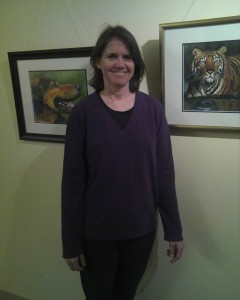Meet Linda Patrick, Artist and Caregiver
[caption id="attachment_1533" align="alignleft" width="175"] Linda at her first art exhibit[/caption] Linda’s interest in working with elders grew from experiences in family caregiving first with her courageous, lonely, loving grandmother and later her parents. During the five years that she’s shared her skills through With A Little Help she says she most enjoys “being a support to families.” Her own experience caring for parents helps her interact with client families. “I am able to offer a calm, neutral, and supportive influence,” she explained. “It is very heart opening to see families connect and support each other in times of need. I believe our families are the main way we can work through our karma/life lessons and if we don’t heal our relationships with them, we have really missed a great opportunity. I encourage everyone to do this difficult work of healing relationships with their own families. How else can we have peace on earth?”
Linda at her first art exhibit[/caption] Linda’s interest in working with elders grew from experiences in family caregiving first with her courageous, lonely, loving grandmother and later her parents. During the five years that she’s shared her skills through With A Little Help she says she most enjoys “being a support to families.” Her own experience caring for parents helps her interact with client families. “I am able to offer a calm, neutral, and supportive influence,” she explained. “It is very heart opening to see families connect and support each other in times of need. I believe our families are the main way we can work through our karma/life lessons and if we don’t heal our relationships with them, we have really missed a great opportunity. I encourage everyone to do this difficult work of healing relationships with their own families. How else can we have peace on earth?” 23 June, 2014

